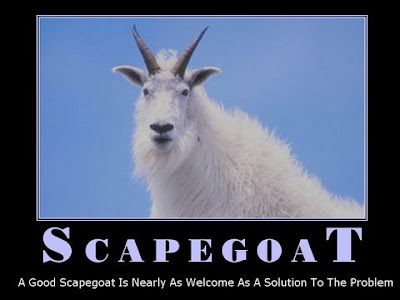6 “Then Aaron shall offer the bull for the sin offering which is for himself, that he may make atonement for himself and for his household.
7 “He shall take the two goats and present them before the LORD at the doorway of the tent of meeting.
8 “Aaron shall cast lots for the two goats, one lot for the LORD and the other lot for the scapegoat.
9 “Then Aaron shall offer the goat on which the lot for the LORD fell, and make it a sin offering.
10 “But the goat on which the lot for the scapegoat fell shall be presented alive before the LORD, to make atonement upon it, to send it into the wilderness as the scapegoat.
21 “Then Aaron shall lay both of his hands on the head of the live goat, and confess over it all the iniquities of the sons of Israel and all their transgressions in regard to all their sins; and he shall lay them on the head of the goat and send it away into the wilderness by the hand of a man who stands in readiness.
22 “The goat shall bear on itself all their iniquities to a solitary land; and he shall release the goat in the wilderness.
As I watched the announcement of the verdict in the trial of Michael Jackson’s doc, Conrad Murray, quite a number of persons interviewed referred to him as a scapegoat.
That term has an interesting etymology.
Ignoring for the moment discussions as to whether the term was correctly translated from the Hebrew, the scapegoat was originally more correctly known as the “escape goat”, which over time became “scapegoat”.
In Biblical times, the record of the sins of the Israelites was transferred to the Tabernacle by the blood of sacrifices.\
It 's a bit like Santa having a list of all the children who have been naughty during the past year. Children who have been good get a present; children who have been bad receive a lump of coal in their stocking. And if you think that that might be traumatic for children, I have previously posted that I grew up in a Dutch household where tlittle kids are taught that Santa (more correctly, Saint Nicholas) has a Moor helper, Black Pete, who takes the naughty children away to Spain in his sack, never seeing their parents again. None of your wussy lump of coal there. But I disgress.
As set out in Leviticus 16 above, on the Day of Atonement aka Yom Kippur, the High Priest presented a ram and two young goats as sacrifices for the sins of the people. The ram was made a burnt offering; one of the goats, selected by lot, was slain as a sin-offering. As for the other goat, the High Priest laid his hands on its head and confessed over it the sins of the people. The collective recorded sins of the people of Israel were transferred to the goat and the Tabernacle was cleansed. The sin laden goat was then let go in the wilderness. From the point of view of the goat, being made a scapegoat was preferable to the alternative.
The concept of the scapegoat, as set out in Leviticus, has been interpreted as symbolic of the self-sacrifice of Jesus, the taking upon himself of the sins of humanity.
Over time the word has broadened to mean a person who is blamed and punished for the sins, crimes or sufferings of others, generally as a way of distracting attention from the real causes.




No comments:
Post a Comment
Note: Only a member of this blog may post a comment.